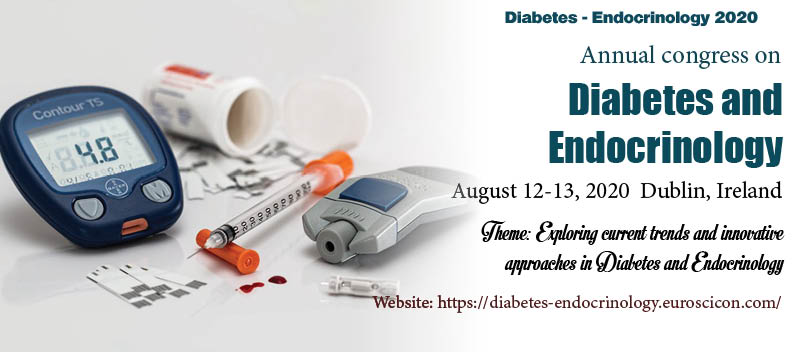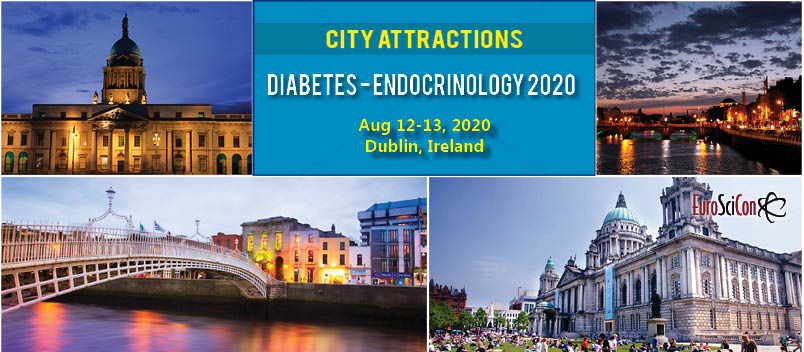Diabetes - Endocrinology 2020
INVITATION
Hear Explore and learn the latest research. Present before distinguished Informatics audience. Collaborate, build partnerships and experience Dublin. Join the Diabetes and Endocrinology Experts
We are pleased to invite you all to the “World Conference on Diabetes and Endocrinology” Webinar which will take place on Aug 24, 2020, hosted by Euroscicon.
The conference will bring together Diabetes Researchers and practitioners from more than 40 nations to share their knowledge, experience, and expertise through a series of Key Notes, Plenary Talks, Workshops, Symposiums, and Exhibitions. The theme of this year conference is “Exploring current trends and innovative approaches in Diabetes and Endocrinology” and the audience is expected from wide disciplines which include but not limited to Diabetes and Endocrinology, Pediatric Endocrinology, Cardiovascular Diabetes, Reproductive Endocrinology, Gastrointestinal and Neuroendocrine Tumours, Diabetic neuropathy, Diabetic Retinopathy, Obesity and metabolic diseases, Endocrine Oncology, Adrenal and Thyroid Disorders, Gestational diabetes and other experts working in the related area of Diabetes and Endocrinology to share their experience at the global platform.
Dublin a gorgeous city with many hidden secrets poses one of the world’s most promising destinations to visit and experience the special tourist attractions. Attending and contributing to the conference will definitely enhance your cultural and scientific experience and open further opportunities for you and your career.
With Best Wishes,
Organizing Committee
ABOUT CONFERENCE
Euroscicon proudly announces the “Annual Congress on Diabetes and Endocrinology” during Aug 12-13, 2020 Dublin, Ireland with the theme “Exploring current trends and innovative approaches in Diabetes and Endocrinology”. Euroscicon through its Open Access Initiative is committed to making genuine and reliable contributions to the scientific community.
DIABETES- ENDOCRINOLOGY 2020 aims to focus on the critical parts ensuring that the knowledge and contribution of Diabetes to patient outcomes are found within the electronic health record and can be linked to patient outcome. It also helps in discovering advances in health practice and management for health disparities too.
Conference Topics
Diabetes and psychiatric disorders
Gastrointestinal and Neuroendocrine Tumours
Obesity and metabolic diseases
Diabetes diagnosis and treatment
Nanotechnology for diabetes treatment
Diabetic Disorders and Treatment
Advanced Technologies for Treatment of Diabetes
About Subject
Diabetes mellitus is commonly known as diabetes. It is a group of metabolic disorders characterized by high blood glucose levels over a prolonged period. Symptoms of high blood glucose include frequent urination, increased thirst, and hunger. Acute complications can include diabetic ketoacidosis, hyperosmolar hyperglycemic state, or even death. Endocrinology is a branch of medicine that deals with the endocrine system, its diseases, and its specific secretions such as hormones. It is also concerned with the integration of developmental events, proliferation, growth, differentiation, and the psychological or behavioural activities of metabolism, growth and development, tissue function, sleep, digestion, respiration, excretion, mood, stress, lactation, movement, reproduction, and sensory perception caused by hormones.
Diabetes and Endocrinology Conference will provide exposure for the possibilities in the field of Diabetes. It is very beneficial for the students, physicians, endocrinologists, doctors, health care people, professors because it provides knowledge in this field. It also gives opportunities to the Diabetes and Endocrinology societies to showcase their knowledge and have face to face meetings with scientists, increasing their business opportunities and also gives the opportunity to know about their market competitors. It allows nurses of all levels of experience to participate in an area of career and education growth that is not easily found within the structure of the workplace. We assure, our attendees would return to their hospitals with confidence to improve their Diabetes practice, equipped with certified procedures to work with.
Who Can Attend?
Leading world Doctors, Endocrinologists, health care professionals, Professors, Research fellows, are leading universities, students, directors of association and societies.
Diabetes and Endocrinology 2020 conference brings together individuals who have an interest in different fields of Diabetes and Endocrinology like Diabetes, Endocrinology, Pediatric Endocrinology, Cardiovascular Diabetes, Reproductive Endocrinology, Gastrointestinal and Neuroendocrine Tumours, Diabetic neuropathy, Diabetic Retinopathy, and medicine from practice, research, administration, policy and education. It is a forum to explore issues of mutual concern as well as exchange knowledge, share evidence, ideas, and generate solutions.
A Unique Opportunity for Advertisers and Sponsors at this International event:
https://diabetes-endocrinology.euroscicon.com/sponsors
https://diabetes-endocrinology.euroscicon.com/exhibition
SESSIONS
Diabetes mellitus is commonly known as diabetes. It is a group of metabolic disorders characterized by high blood glucose levels over a prolonged period. Symptoms of high blood glucose include frequent urination, increased thirst, and hunger. Acute complications can include diabetic ketoacidosis, hyperosmolar hyperglycemic state, or even death. Serious long-term complications include cardiovascular disease, stroke, chronic kidney disease, foot ulcers, and damage to the eyes. Diabetes is due to either the pancreas not producing enough insulin, or the cells of the body not responding properly to the insulin produced.
Endocrinology is a branch of medicine that deals with the endocrine system, its diseases, and its specific secretions such as hormones. It is also concerned with the integration of developmental events, proliferation, growth, differentiation, and the psychological or behavioural activities of metabolism, growth and development, tissue function, sleep, digestion, respiration, excretion, mood, stress, lactation, movement, reproduction, and sensory perception caused by hormones. The endocrine system consists of several glands in different parts of the body that secrete hormones directly into the blood rather than into a duct system. Therefore, these glands are regarded as ductless glands.
2. Diabetes and psychiatric disorder:
The experience of living with diabetes is often associated with concerns specific to the illness and can also cause conditions, such as diabetes distress, psychological insulin resistance and the persistent fear of hypoglycaemic episodes. A wide range of psychiatric disorders, including major depressive disorder, bipolar and other related disorders, schizophrenia spectrum and other psychotic disorders, anxiety disorders, sleep disorders, eating disorders and stress-related disorders are mostly seen in people with diabetes compared to the general population. Individuals living with diabetes and burdensome issue are at expanded hazard for before all-cause mortality contrasted with individuals living with diabetes without a past filled with despondency.
All people with diabetes ought to be consistently screened for the nearness of diabetes trouble, just as side effects of normal mental issue. Contrasted with those with diabetes just, people with diabetes and emotional well-being concerns have diminished cooperation in diabetes self-care, a diminished personal satisfaction, expanded practical weakness; expanded danger of confusions related with diabetes, and expanded social insurance costs. Intellectual conduct treatment, persistently focused methodologies (for example inspirational meeting), stress the executives, adapting aptitudes preparing, family treatment and community-oriented case the executives ought to be joined into an essential consideration. Self-administration aptitudes, instructive intercessions that encourage adjustment to diabetes, tending to co-happening emotional wellness issues, lessening diabetes-related trouble, the dread of hypoglycaemia, and mental insulin obstruction are for the most part supportive. People taking mental prescriptions, especially (however not constrained to) atypical antipsychotics, advantage from standard screening of metabolic parameters to recognize glucose dysregulation, dyslipidaemia and weight gain over the span of the ailment with the goal that proper mediations can be founded.
3. Parathyroid Ultrasonography:
The evolving role of the radiologist. Especially for symptomatic non-functioning parathyroid cysts, simple aspiration is a first-line procedure for diagnosis and treatment, while ethanol ablation is a subsequent treatment modality for recurrent cases. The importance of sonography and sestamibi scintigraphy in the preoperative evaluation of patients with primary hyperthyroidism has increased with the adoption of minimally invasive Para thyroidectomy techniques at most medical centres. When the results of these studies are concordant, the cure rates of minimally invasive surgery equal those of traditional bilateral neck exploration.
Previously, radiologists played a limited role in the treatment of parathyroid disease, primary focusing on the preoperative localization of parathyroid lesions responsible for hyperparathyroidism. But, the widespread use of high-resolution ultrasound has lead to the increasing detection of parathyroid incidentalomas (PTIs). Consequently, radiologists may be required to differentiate PTIs from thyroid lesions, which is most reliably accomplished through the fine needle aspiration-parathyroid hormone analysis. Various nonsurgical treatment modalities for hyper functioning parathyroid lesions have been developed with some efficacy. Especially for symptomatic non-functioning parathyroid cysts, simple aspiration is a first-line procedure for diagnosis and treatment, while ethanol ablation is a subsequent treatment modality for recurrent cases. Long-standing disease and poor blood glucose control, and who take insulin have the major fracture risk. The onset of type 1 diabetes typically occurs at the younger age when bone mass is still increasing. It is possible that people with type 1 diabetes achieve lower peak bone mass, the highest strength.
The parathyroid glands are endocrine glands located in the visceral space of the neck. They produce parathyroid hormone, which controls calcium homeostasis. The parathyroid glands can have a variable location (from carotid bifurcation to anterior mediastinum) but are usually in close relation to the thyroid gland, in the region of the tracheoesophageal groove.
Radiographic features: Ultrasound and nuclear medicine is the predominant parathyroid imaging techniques with cross-sectional (CT/MRI) imaging usually reserved to confirm the anatomical position of ectopic parathyroid adenomas 2-3.
Pediatric endocrinology is a medical subspecialty dealing with disorders of the endocrine glands. Such as variations of physical growth and sexual development in childhood, diabetes and many more. The specialty also deals with hypoglycemia and other forms of hyperglycemia in childhood, variations of puberty, as well other adrenal, thyroid, and pituitary problems. By age, pediatric endocrinologists, depending upon the age range of the patients they treat and care for patients from infancy to late adolescence and young adulthood. The most common disease of the specialty is type-1diabetes, which usually accounts for at least 50% of a typical clinical practice. The next most common problem is growth disorders, especially those amenable to growth hormone treatment. Pediatric endocrinologists are usually the primary physicians involved in the medical care of infants and children with intersex disorders.
Over the past few decades, cardiovascular disease and diabetes have emerged as major public health problems, both as distinct clinical entities and as comorbid conditions.
6. Reproductive Endocrinology:
Reproductive endocrinology and infertility is a surgical subspecialty of obstetrics and gynecology. This trains physicians in reproductive medicine addressing hormonal functioning as it pertains to reproduction as well as the issue of infertility. While most REI specialists primarily focus on the treatment of infertility, reproductive endocrinologists are trained to evaluate and treat hormonal dysfunctions in females and males outside infertility. Reproductive endocrinologists have specialty training in obstetrics and gynecology before they undergo sub-specialty training in REI.
7. Gastrointestinal and Neuroendocrine Tumours:
Gastrointestinal neuroendocrine tumours highly diverse group of tumours formed from one type of neuroendocrine cell. These cells are scattered throughout the chest and abdomen, but most are seen in the GI tract. Neuroendocrine cells make hormones that help to control digestive juices and the muscles used in moving food through the stomach and intestines. Gastrointestinal neuroendocrine tumours sometimes also make hormones and release them into the body. These tumours basically grow slowly and are classified as low-grade tumours, but in some cases may begin to grow rapidly.
Another type of tumour that arises in the adrenal glands is called pheochromocytoma which is sometimes classified as a neuroendocrine tumour. Carcinoid tumours are by far the most common type of neuroendocrine tumours which are found in the gastrointestinal system. Neuroendocrine tumours that arise in the lungs are also known as pulmonary neuroendocrine tumours.
Diabetic nephropathy is related to the diabetic kidney disease. In this the chronic loss of kidney function occurs in those with diabetes mellitus. Protein loss occurs in the urine due to damage to the glomeruli which may become tremendous, and causes a low serum albumin with resulting generalized body swelling and result in the nephrotic syndrome. For few people, diabetic nephropathy can progress to chronic kidney disease and kidney failure. However, majority of the people with diabetes do not develop kidney disease that progresses to kidney failure.
The main function is to filter waste products and excess water from the bloodstream so that they can be excreted in the form of urine, which is carried out by a system of tubes and blood vessels known as nephrons. Inside the nephrons, there are tiny blood vessels called capillaries and tiny urine-collecting tubes. One of the major structures in the nephron is a group of blood vessels known as the glomerulus, which acts as a filter. Having high blood sugar levels can interfere with the function of the glomerulus. The filtering function of the kidneys doesn’t work properly and proteins start to leak from the blood into the urine.
Diabetic retinopathy, which is also known as diabetic eye disease, is a medical condition in which damage occurs to the retina due to diabetes mellitus. It is a most important cause of blindness. Diabetic retinopathy affects up to 80% of those who have had diabetes for more than 20 years. At least 90% of the new cases could be reduced with the proper treatment and monitoring of the eyes. The retina is the membrane which covers the black of the eye and is highly sensitive to light. It can convert any light that hits the eye into signals which can be interpreted by the brain. This process produces visual images and this is how sight functions in the human eye. Diabetic retinopathy damages the blood vessels in the retinal tissue, causing them to leak fluid and distort vision.
Damage to the small blood vessels and neurons of the retina causes Diabetic retinopathy. The earliest changes leading to diabetic retinopathy include narrowing of the retinal arteries associated with decreased retinal blood flow; dysfunction of the neurons of the inner retina, followed in later stages by changes in the function of the outer retina, associated with subtle changes in visual function; dysfunction of the blood-retinal barrier, which protects the retina from many substances in the blood leading to the leaking of blood constituents into the retinal neuropile.
10. Obesity and metabolic diseases:
Obesity is a condition in which a human has excess body fat. Obesity can increase a person's risk of diseases, health problems, including high blood pressure, diabetes and heart disease. Obesity is mostly caused by a combination of excessive food intake, lack of physical activity, and genetic susceptibility. A few cases are caused primarily by genes, endocrine disorders, medications and mental disorder. The view that obese people eat little yet gains weight due to a slow metabolism which is not medically supported. Most of the obese people have greater energy expenditure than their normal counterparts due to the energy required to maintain an increased body mass.
A metabolic disorder occurs when the metabolism process fails and causes the body to have either too much or too little of the essential substances to stay healthy. Metabolic disorders can take many forms such as a missing enzyme or vitamin that’s necessary for an important chemical reaction, abnormal chemical reactions that hinder metabolic processes and disease in the liver, pancreas, endocrine glands, or other organs involved in metabolism. Metabolic disorders can be present at birth and many can be identified later by routine screening. If a metabolic disorder is not identified early, then it may be diagnosed later in life, when symptoms appear. Specific blood and DNA tests can be done to diagnose genetic metabolic disorders. The gut microbiota, which is a population of microorganisms live in the human digestive system, also has an important part in metabolism and generally has a positive function for its host.
11. Endocrine Oncology:
Diabetes and cancer are prevalent diseases with major impact on health worldwide. Epidemiologic witness suggests that people with diabetes are at notably higher risk for many forms of cancer. Type 2 diabetes and cancer share several risk factors, but possible biologic links between the two diseases are incompletely understood. Moreover, witness from observational studies suggests that few medications used to treat hyperglycemia are correlated with either increased or reduced risk of cancer.
Endocrine cancers growths are those found in tissues of the endocrine framework, that incorporates the thyroid, adrenal, pancreas, parathyroid, and pituitary organs.
12. Adrenal and Thyroid Disorders:
Adrenal glands are small glands which are located on top of each kidney. They produce those hormones without which we can't live, including sex hormones and cortisol. Cortisol is that hormone which helps you respond to stress and has many other important functions as well. In Cushing's syndrome, cortisol amount is too much, while on the other hand with Addison's disease, there is too little. The thyroid gland which influences almost all of the metabolic processes in our body. Thyroid disorders which can be range from a small, harmless goitre (enlarged gland) which required no treatment to life-threatening cancer. Too much thyroid hormone present in our body results in a condition known as hyperthyroidism. Insufficient hormone production leads to hypothyroidism.
13. Gestational diabetes:
Gestational diabetes is a condition in which a woman without diabetes develops high blood glucose levels during pregnancy. Gestational diabetes generally results in some symptoms however; it does increase the risk of pre-eclampsia, depression, and requiring a Caesarean section. Babies born to mothers with poorly treated gestational diabetes are at increased risk of being too large, having low blood glucose after birth, and jaundice. If untreated, it can also result in a stillbirth. Long term, children are at major risk of being overweight and developing type 2 diabetes.
Gestational diabetes is caused by not enough insulin. Diagnosis can be done by blood tests. Prevention is by maintaining a healthy weight and exercising before pregnancy
14. Osteoporosis and Diabetes:
People with diabetes, particularly type 1 diabetes, often have poor bone quality and a high risk of fractures. Those with long-standing disease and poor blood glucose control, and who take insulin have the major fracture risk. The onset of type 1 diabetes typically occurs at the younger age when bone mass is still increasing. It is possible that people with type 1 diabetes achieve lower peak bone mass, the highest strength and density that bones reach. People basically reach their peak bone mass in their 20s. Low peak bone mass can increase one’s risk of developing osteoporosis later in their life.
Some of the complications of diabetes, such as nerve damage, muscle weakness, episodes of low blood sugar, and vision problems can increase the risk of fractures.
15. Diabetes diagnosis and treatment:
Health Care professionals can diagnose diabetes, prediabetes, and gestational diabetes through blood tests. The blood tests show if your blood glucose, is too high or low. Some people will not have any direct symptoms but may have some indirect risk factors and need to be tested. Testing allows health care professionals to find diabetes and work with their patients to manage diabetes and prevent complications. Doctors usually investigate type 1 diabetes in children and young adults, because type 1 diabetes can run in families. A study called Trial Net offers free testing to family members of people with the disease, even if they don’t have symptoms. Experts suggests testing children between the ages of 10 and 18 who are overweight or obese and have at least two other risk factors for developing the disease
16. Nanotechnology for diabetes treatment:
Nanotechnology is expanding its significance in diabetes in the on-going decade. It has proven beneficial in treating diabetes mellitus by not only improving the catalytic properties of electrodes but also by increasing the available surface area of the sensor-receptor complex. This can transform insulin delivery through enhanced oral formulations and islet encapsulation. A portion of the uses of nanotechnology in treating diabetes mellitus are fake pancreas, rather than pancreas transplantation utilization of counterfeit beta cells, for oral conveyance of insulin utilization of nanospheres as biodegradable polymeric bearers and so on. At present insulin for Type 1 diabetes is delivered by injection, as orally administered insulin has limited effectiveness.
17. Diabetes and Epidemiology:
The number of people suffering with diabetes has been raised from 108 million in 1980 to 422 million in 2014.The global prevalence of the disease diabetes among adults over 18 years of age has risen from 4.7% in 1980 to 8.5% in 2014. Diabetes prevalence has been increasing more rapidly in middle and low-income countries. It is a major cause of blindness, kidney failure, heart attacks, stroke and lower limb amputation. Almost half of all the deaths attributable to high blood sugar occur before the age of 70 years. Healthy diet, regular physical activities, maintaining a normal body weight and avoiding tobacco use are important ways to prevent or delay the onset of type 2 diabetes.
Diabetes can be treated and its consequences with diet, physical activity, medication, regular screening and treatment for complications.
18. Diabetes Nursing:
The most important feature of diabetes management is the self-management of diabetes which can be successfully achieved, and complications prevented with the help and support of the nursing team. Diabetes specialist nurses play an important role in screening diabetic persons, detecting early onset of diabetes, assessing nutritional needs of the patient, promoting self-management, providing prevention advice, spreading awareness on diabetes and providing health coaching. In this context, it is extremely necessary for nurses to be well educated, trained and skilled adequately to be able to proficiently deliver care, support self-management and provide advice to diabetic persons.
Diabetics are more prone in developing dental complications than those who have proper control over their blood sugar level. There are several host of dental and gum diseases associated with diabetes including gingivitis, periodontitis (mild and severe), fungal infections, dry mouth, loose teeth and so on. Prolonged levels of blood sugar can lead to developing or worsening of dental infections. Keeping a check on the blood sugar level, maintaining proper oral and dental hygiene can help mitigate such complications.
20. Diabetic Disorders and Treatment:
Diabetes, frequently referred to by specialists as diabetes mellitus, depicts a gathering of diabetes and metabolic sicknesses in which the individual has high blood, either in light of the fact that insulin generation is lacking, or on the grounds that the body's phones don't react appropriately to insulin, or both. Patients with high glucose will normally encounter polyuria; they will turn out to be progressively parched, and hungry. Recognizing type 1 and type 2 diabetes at determination is very critical. Average qualities of type 2 diabetes incorporate slow and guileful onset, most normal in overweight or fat patients from a minority bunch, signs of insulin resistance, robust case history of kind a pair of diabetes. Familial way of life danger components prompting heftiness might be available, as may a family history of cardiovascular disease or metabolic disorder. Pediatric Diabetes is a type 1 diabetes mellitus requires insulin treatment.
21. Advanced Technologies for Treatment of Diabetes:
The conception of 'new innovations' for type one diabetes and new revelation and propelled type 2 diabetes treatment has extended as currently at a rate that some ought to seriously think about just like 'Moore's Law', and therefore the sheer range of recent advancements going into the type one diabetes business centre is likewise developing at a surprising rate. From the patient's viewpoint, this is energizing as well as can prompt a feeling of positive thinking. Advancements that today are developing typical, and so forth go under new remedial instruments of diabetes. Without a doubt, it might be contended that the $64000 advances in type one diabetes care made within the half-moon of a century have originated from innovation rather than science. In the in the meantime, not all new innovations succeed, paying very little relevance their silent guarantee. Both type 1 diabetes patients and their medicinal services suppliers will soon see a progression of further propelled therapeutic advancements utilized as a part of doctor's facility and new innovations and novel treatments in diabetes treatment whose premise is fixing to the idea of enhancing the lives of those with the malady.
Molecular Biomarkers is demarcated as “a characteristic that's accurately measured Associate in Nursing gauged as a pointer of traditional biological procedures, infective procedures, or medicine responses to a pharmaceutical intervention. Biomarkers play Associate in Nursing very important half in leading clinical trials and treating patients. Advances in molecular medical specialty facilitate medical professionals create knowledgeable, scientifically valid selections. Additional well-organized discovery and usage of biomarkers within the growth of anti-diabetes medication can rely on fast our understanding of the pathological process of diabetes and specifically its macro-vascular complications. Procedural enhancements from different fields, particularly cancer, are getting down showing the manner towards higher models of diabetes pathological process and molecular biomarker discovery.






